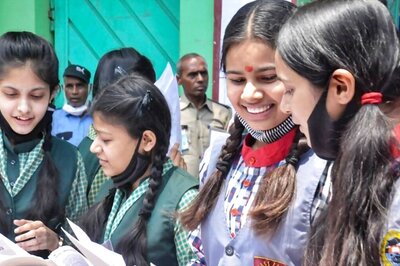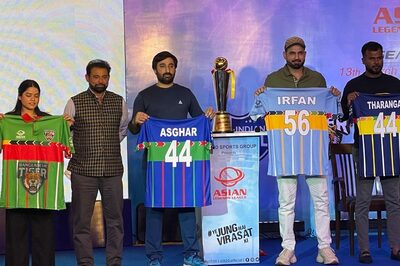
views
The CNN-IBN-The Week post-poll surveys conducted by the CSDS reveal surprising trends among voters in all four states.West Bengal: TMC+Congress: 222-234 seats. Left Front: 60-72.Tamil Nadu: AIADMK alliance: 120-132 seats. DMK alliance: 102-114.Kerala: LDF: 69-77 seats. UDF: 63-71.Assam: Congress: 64-72 seats. AGP: 16-22. AUDF: 11-17. BJP: 7-11.A perfect antidote to hubris, democracy cures not just the arrogance of power, it also serves to mitigate the certitudes of intellect. Like politicians, elections are the one moment when political analysts must submit their reading, their projections, their grand designs to the test of ordinary citizen. As in the case of politicians, this can be an humbling experience for those in the business of analyzing politics.
If the CNN-IBN-The Week post-poll surveys conducted by the CSDS are anything to go by, the current round of assembly elections holds many lessons for national and local analysts of politics. These surveys of three to five thousand electors in each of the four states that went to polls recently throw up indicators that defy established political common sense.
This common sense had suggested that the UDF’s victory in Kerala was a forgone conclusion, while Assam was bound to witness a hung assembly with no party anywhere close to the majority mark. Also that Mamata Banerjee held an edge in West Bengal, but the Left Front had staged a partial recovery since the debacle in 2009. And that Tamil Nadu was a thriller, but political analysts expected things to swing decisively in favour of the AIADMK by polling day.
The survey findings invite us to rethink this established common sense.
When the elections were announced, Kerala appeared all set for a boring repetition of a three-decade old cycle of oscillation of power in each election. There were some reports of V S Achutanandan’s having turned things around for the Left, but not many took this seriously. In a lighthearted vain I called it a conspiracy of the Malayali media to create suspense where none existed. The findings of the CSDS survey team led by Dr Sajjad Ibrahim show how uninformed such comments made by people sitting in Delhi can be.
The survey shows that the Left Front government enjoys a fairly decent approval rating, and not just among traditional LDF supporters. V S Achutanandan leads the popularity charts for Chief Minister’s position, way ahead of the Congress’s Oommen Chandy or any of his rivals in his own party. A suggestion that this 87-year-old leader may be too old to hold the CM’s position is dismissed vehemently, even by those below 25. It also hints at a more fundamental transformation in the political landscape of the state.
Slowly but surely, the proportion of ‘unattached voters’ has gone up in the state, thus creating a space for an open-ended judgment on the performance of government, detached from the iron law of alteration of government. We cannot be sure that the 30-year-old pattern will be reversed this time, but this possibility cannot be ruled out.
In Assam, political common sense suggested that the logic of ethnic and political fragmentation was bound to reach a new high, resulting in a badly hung assembly. The Congress had finished well short of a majority in 2006, forming the government with support from the Bodo Peoples Front. This time the ruling party was expected to slide further, paving the way for a resurgent and reunited AGP to have a shy at forming the government. But the findings of the CSDS survey led by Dr Dhruba Kumar Sharma could surprise everyone, including Congressmen.
Tarun Gogoi, the sitting Chief Minister, stands tall among all political leaders; people think that his second term was better than his first government. There is a fair degree of approval for much of what his government has done on routine developmental matters. The serious allegations of corruption do not seem to have reached ordinary voters or affected their judgment.
What appears to have worked for Gogoi is his determined initiative for peace with ULFA and his dogged refusal to have any truck with AIUDF, seen as a party of Bengal Muslim immigrants. The CSDS survey shows that the Congress has begun a recovery among the Ahomiya Hindus and the Assamese speaking Muslims. Unable to keep alive the foreigners issue or to reincarnate itself as a normal party of developmental issues, the AGP may suffer further decline just when it expected to stage a recovery. We do not still know if the Congress will get a clear majority, but an improvement from 2006 for the Congress party could begin the process of long term political realignment in the state.
Of all the four states, Tamil Nadu appears to have lived up to its promise of a thriller. The DMK had surprised everyone by its thumping victory in the Lok Sabha elections. No one expected it to repeat that kind of victory and the public mood in urban areas had visibly shifted against the ruling party. Jayalalitha’s alliance with Vijayakanth’s DMDK appeared to have sealed the deal in her favour. When Karunanidhi and Stalin change their old constituencies, you know there is trouble. Among neutral political analysts there was an anticipation of clear victory for the AIADMK-led alliance.
The CSDS team led by Professor Koteshwar Prasad invites us to nuance this picture. The AIADMK does appear to be ahead – but only by a whisker - in a very tight election. The alliance with the DMDK appears to have worked well at the voters’ level despite the well-publicized problems at the top. When it comes to corruption and nepotism, the DMK in general and Karunanidhi in particular is rated poorly. But this is not true for his general record of governance.
The general ratings of Karunanidhi’s government, the record of delivery of public services and the proportion of ordinary people who have benefited from government schemes would put the best-performing governments in north India to shame. He might still lose the election, and the margin of his defeat could be bigger than what the survey anticipates if fear and greed are as widespread as reported, but this would not be a non-performing government being booted out.
The political common sense in West Bengal had shifted in the last six months before elections. Every political analyst and worker said that the Left had recovered from the shock they received in 2009, that their phenomenal election machine was back to work, that the party had made amends for some of their worst follies and that their candidate selection was superb. There was some evidence to back the claims of Left recovery: the local bodies controlled by the TMC and the Congress have been a disaster and the Left have done well in recent student union elections across the state. So, this election was going to be closer than the Lok Sabha election and the Left could even pull it off.
After talking to nearly 5,000 people across the state, the CSDS team led by Dr Supriyo Basu nails this misreading. The evidence shows what everyone suspected: the tide of anger against the Left has continued unabated and is most intense in the areas that the Left considered its bastions. The erosion of votes is most intense not just among the urban middle classes and the intelligentia, but also among the urban and rural poor.
Buddhadeb Bhattacharjee’s ratings have taken a nosedive, as he is rated very poorly compared to his predecessor Jyoti Basu; his recent government is rated worse than his own first government. The LF government is indicted on all the expected counts: Singur, Nandigram, Nitai, Rizwanur’s killing. The desire for ‘pariborton’ (change) has very little content as of now. It has a symbol in Mamata Banerjee and a lot of undefined hope. While we cannot be sure about the margin of Left’s defeat – if residual fear has resulted in some over-reporting for the Left, then we could even be looking at a 1977 kind of rout for the Left – it is clear that Writers’ Building will have new faces this time.
This is not the first time that survey evidence has gone against political common sense. In we keep the history of these divergences in mind, we can learn two valuable lessons. One, it is pointless to quarrel with this evidence just because it flies in the face of what every sensible and reasonable political analyst believes. Time and again such analysis has been proven to be wrong. At the same time, it is equally presumptuous to think that survey findings are election outcomes. Fortunately, we only have to wait for May 13 to hear the voice of the people.
####Assam


Kerala


Tamil Nadu


West Bengal




















Comments
0 comment